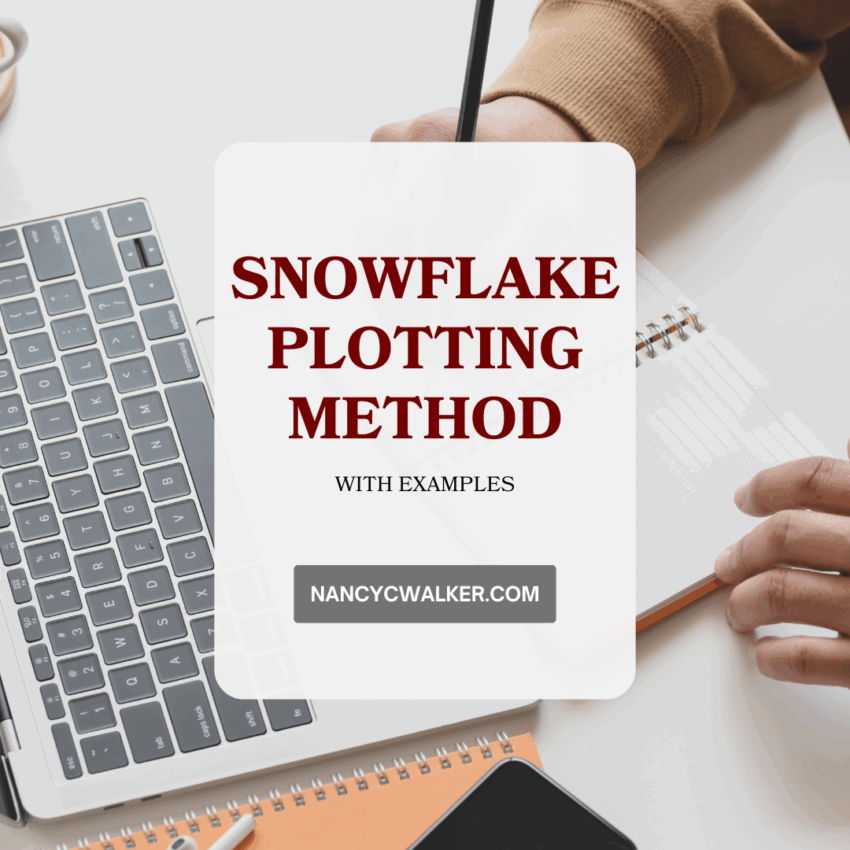This article is part of a series about how you can plot a novel.
Sometimes I want to plot a story but all I have is the main idea. This is where Randy Ingermanson’s Snowflake Method comes in. It’s an organic approach to plotting that provides the author with an organic structure to build the story, craft the outline, and develop the story’s world and characters. It emphasizes maintaining an emotional connection with the reader, ultimately strengthening the author’s craft. I discovered this plotting method while researching how to outline my first novel and appreciate its simple, step-by-step development process.
So, how does it work? Let’s break it down!
Step 1: The One-Sentence Summary
This is your story’s elevator pitch, boiled down to its absolute essence. It should include your main character and their primary goal, all in 15 words or fewer.
Example: A timid mage must brave a dragon’s lair to retrieve a stolen amulet and save her village.
Step 2: Expand to a Paragraph
Now, take that single sentence and flesh it out into a full paragraph. This is where you can start hinting at the setup, the major obstacles your character will face, and how the story might conclude.
Example: Elara, a young apprentice mage, lives in a quiet village threatened by a shadow plague. When a powerful, ancient amulet, the only cure, is stolen by a fearsome dragon, Elara, despite her crippling fear, must embark on a perilous journey to reclaim it. Along the way, she’ll face magical creatures, treacherous landscapes, and her own self-doubt, ultimately discovering a strength she never knew she possessed to save her people.
Step 3: Character Deep Dive
Time to get to know your stars! For each main character, create a one-page summary. Include their name, goal, motivations, conflicts, flaws, and how they’ll change throughout the story. Don’t forget a one-sentence and one-paragraph summary of their internal journey (their “arc”).
Example (for Elara):
- Name: Elara Meadowlight
- Goal: Retrieve the Amulet of Lumina to cure her village.
- Motivations: Love for her family and community, a sense of duty, desire to prove herself.
- Conflicts:
- External: Dragon, magical creatures, treacherous journey.
- Internal: Overcoming her fear, self-doubt, past failures.
- Flaws: Timid, easily discouraged, underestimates her own abilities.
- How she will change: Transforms from a fearful apprentice into a brave, confident mage.
- Internal Arc (one sentence): A fearful mage learns to embrace her inner power.
- Internal Arc (one paragraph): Elara, always overshadowed by her more confident peers, has long doubted her magical abilities. The quest for the amulet forces her to confront her deepest fears and insecurities. Through facing daunting challenges and relying on her nascent magical skills, she gradually sheds her timidity, learning to trust her instincts and the dormant power within her, ultimately becoming the hero her village desperately needs.
Step 4: Paragraphs from Sentences
Go back to your paragraph from Step 2. Now, take each sentence from that paragraph and expand it into a full paragraph. This adds detail and helps you see if your story concept holds up. Don’t be afraid to tweak the previous steps if something doesn’t feel right here!
Example (expanding on the first sentence of the Step 2 paragraph):
- Elara, a young apprentice mage, lives in a quiet village threatened by a shadow plague.
- Expanded: The village of Oakhaven, nestled in a valley shrouded by ancient woods, had always been a haven of peace and light. Elara, an apprentice under the benevolent Archmage Lyra, had spent her days studying ancient texts and practicing minor charms, dreaming of one day mastering true magic. However, a creeping shadow, a mysterious plague known as the Umbra Blight, had infected the very essence of their world, causing plants to wither, animals to sicken, and even the villagers to fall into a lethargic despair. The once vibrant hues of Oakhaven were now muted, and a sense of impending doom hung heavy in the air, a constant reminder of the encroaching darkness.
Step 5: Character Point of View Descriptions
This is a really insightful step! Write a one-page description of your story from the point of view of each main character. This helps you find their unique voice, identify potential narrators, and even spot plot holes you might have missed.
Example (from Elara’s POV):
- “The blight had stolen the color from everything, even my own heart. I remember the day the Archmage told us the Amulet of Lumina, our only hope, was gone. Stolen by a dragon. A dragon! My hands trembled just thinking about it. Everyone looked to me, to us–the mages. But I’m just Elara, the one who always screws up the simplest spells. How could I face such a creature? Yet, I saw the fear in my mother’s eyes, the weariness in my father’s. I couldn’t stand by. Even if my knees knocked and my magic felt like a flickering candle, I had to try. For Oakhaven.”
Step 6: The Four-Page Synopsis
Now, take all the details you’ve gathered and expand them into a four-page synopsis. The exact page count isn’t as important as just adding more depth and exploring potential minor plotlines that could weave into your main narrative.
Example: (This would be a much longer section, but it would build upon all the previous steps, describing Elara’s journey in more detail, introducing allies and antagonists, specific challenges she faces, and how the magical world interacts with her quest.)
Step 7: Character Charts
With a better understanding of your characters, you can now create detailed character charts. Add significant dates, backstories, quirks, and anything else that makes them feel real and unique.
Example (for Elara):
- Birthdate: Autumn Equinox, 20 years ago.
- Backstory: Grew up in a family of healers, always felt pressured to excel in magic but struggled with confidence because of a childhood accident where a spell went awry.
- Quirks: Bites her lip when nervous, talks to plants, has a deep fear of heights.
- Favorite color: Forest green.
- Biggest secret: Secretly practices ancient, forgotten spells in the dead of night, fearing they are too powerful.
Step 8: Scene List
Using your expanded summary, create a list of all the scenes you’ll need for your story. For each scene, note who the point-of-view character is and summarize what happens.
Example:
- Scene 1: Oakhaven under blight, Elara’s POV. Introduction of the plague, the desperation of the villagers.
- Scene 2: Discovery of the stolen amulet, Archmage Lyra’s POV. The shock and fear, the decision that someone must retrieve it.
- Scene 3: Elara’s reluctant agreement to go, Elara’s POV. Her internal struggle, her commitment despite her fear.
- Scene 4: Journey through the Whispering Woods, Elara’s POV. First encounter with a magical creature, a minor victory that boosts her confidence slightly.
Step 9: Expand Your Scenes
Take each scene from your list and expand on it. Include any conflicts, notes, or pieces of dialogue you want to make sure are present.
Example (expanding on Scene 4):
- Scene 4: Journey through the Whispering Woods, Elara’s POV.
- Conflict: Elara gets lost in the winding paths. The trees seem to whisper menacingly, and she encounters a mischievous sprite who tries to lead her astray.
- Notes: Elara initially tries to reason with the sprite but eventually uses a basic light spell, surprising herself, to scare it off. This is a small moment of empowerment for her.
- Dialogue: “Stay back, you troublesome creature!” Elara stammered, her voice barely a whisper, as she held up her glowing hand. The sprite shrieked and vanished. “I… I did it,” she breathed, a tiny spark of pride igniting within her.
Step 10: Write the Story!
You’ve done all the heavy lifting! Now, with this incredible roadmap you’ve created, it’s time to sit down and write your full story. The Snowflake Method gives you a fantastic foundation, but remember, the magic truly happens when you bring your characters and world to life on the page.
While the Snowflake Method is awesome for building a solid story structure, remember that really fleshing out your characters (their personalities, histories, relationships) often requires a bit more digging. But by combining this method with your own character development magic, you’ll be well on your way to creating truly engaging and well-rounded narratives that readers will fall in love with! Happy writing!

